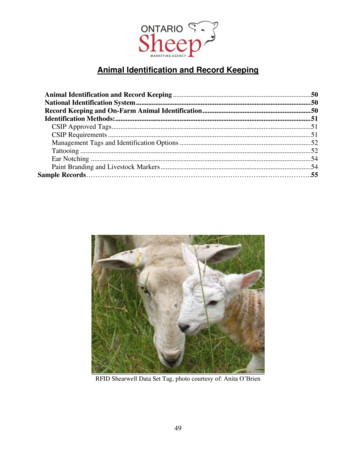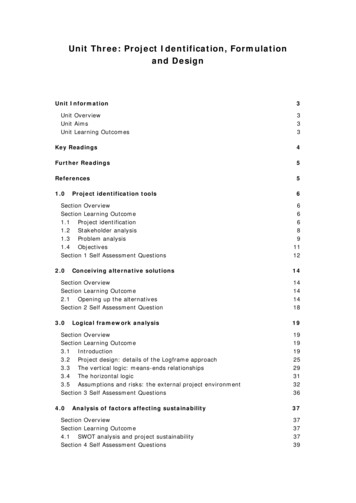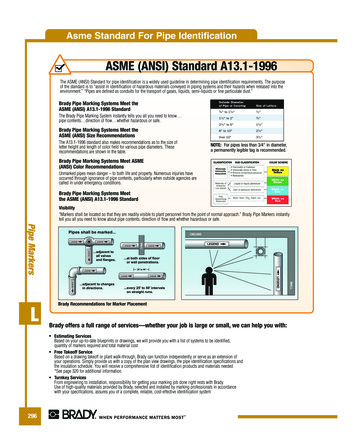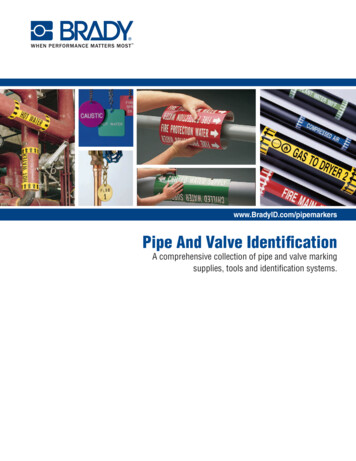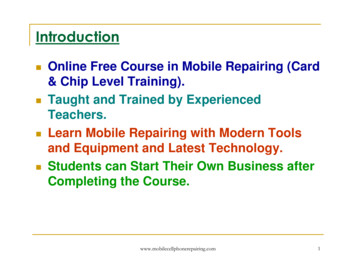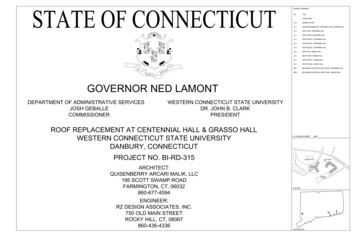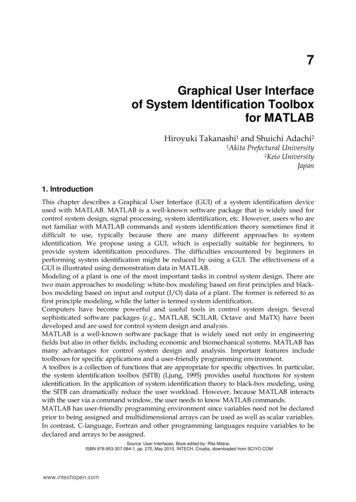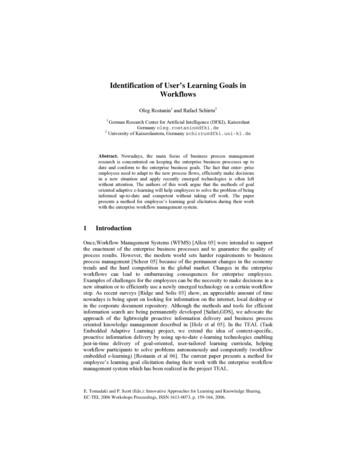
Transcription
Identification of User’s Learning Goals inWorkflowsOleg Rostanin1 and Rafael Schirru21German Research Center for Artificial Intelligence (DFKI), KaiserslautGermany oleg.rostanin@dfki.de2University of Kaiserslautern, Germany schirru@dfki.uni-kl.deAbstract. Nowadays, the main focus of business process managementresearch is concentrated on keeping the enterprise business processes up todate and conform to the enterprise business goals. The fact that enter- priseemployees need to adapt to the new process flows, efficiently make decisionsin a new situation and apply recently emerged technologies is often leftwithout attention. The authors of this work argue that the methods of goaloriented adaptive e-learning will help employees to solve the problem of beinginformed up-to-date and competent without taking off work. The paperpresents a method for employee’s learning goal elicitation during their workwith the enterprise workflow management system.1IntroductionOnce,Workflow Management Systems (WFMS) [Allen 05] were intended to supportthe enactment of the enterprise business processes and to guarantee the quality ofprocess results. However, the modern world sets harder requirements to businessprocess management [Scheer 05] because of the permanent changes in the economytrends and the hard competition in the global market. Changes in the enterpriseworkflows can lead to embarrassing consequences for enterprise employees.Examples of challenges for the employees can be the necessity to make decisions in anew situation or to efficiently use a newly emerged technology on a certain workflowstep. As recent surveys [Ridge and Solis 03] show, an appreciable amount of timenowadays is being spent on looking for information on the internet, local desktop orin the corporate document repository. Although the methods and tools for efficientinformation search are being permanently developed [Safari,GDS], we advocate theapproach of the lightweight proactive information delivery and business processoriented knowledge management described in [Holz et al 05]. In the TEAL (TaskEmbedded Adaptive Learning) project, we extend the idea of context-specific,proactive information delivery by using up-to-date e-learning technologies enablingjust-in-time delivery of goal-oriented, user-tailored learning curricula, helpingworkflow participants to solve problems autonomously and competently (workflowembedded e-learning) [Rostanin et al 06]. The current paper presents a method foremployee’s learning goal elicitation during their work with the enterprise workflowmanagement system which has been realized in the project TEAL.E. Tomadaki and P. Scott (Eds.): Innovative Approaches for Learning and Knowledge Sharing,EC-TEL 2006 Workshops Proceedings, ISSN 1613-0073, p. 159-164, 2006.
Identification of User’s Learning Goals in Workflows2160Goal Orientation in Workflow LearningIn order to achieve the effectiveness of workflow embedded learning (short time andacceptable quality), two requirements have to be met by information assistantsdelivering the task-specific information to their users that are integrated into aWFMS: first, the delivered information has to satisfy the user’s current informationneed (be just-in-time); second, it is necessary that the delivered information does notoverextend the user (just-enough) [Rostanin and Holz 05]. Hence, the concept ofgoal-oriented learning is highly relevant for enterprise workflows. Let’s consider anemployee that is facing a new task. The employee mentally checks if his knowledge issufficient to perform the task. If the necessary knowledge is not present a knowledgegap is identified. From this gap the learning goal “cover the knowledge gap in thecontext of the given task” is identified. For complex tasks more than one learning goalmight be identified.Learning goals influence the learning process in two ways:– They narrow the range of content which is considered necessary to be learned(what to learn).– They guide the learning process by specifying the learning strategy (how to learn).To illustrate the notion of learning strategies, we consider the following example: Asoftware team has to develop a client-server system using the J2EE1 technology. The team consists of one project manager and four programmers.Neither the project manager nor the programmers have experience in programmingwith J2EE, so they have to learn J2EE to accomplish their task. The project manager’slearning goal is to receive knowledge about the architecture of J2EE and about theadvantages of the technology so that he can design the system. An overview of thetechnology is suitable learning content for him. The learning goal of the programmersis to learn how to program the system with J2EE. They require more detailed andspecific learning content than the project manager (including exercises and examples).Even if the same knowledge is involved in both cases, the appropriate learningcontents are different according to the learning goals.According to the above considerations, we define a learning goal as a triple g (c,s,m) where g is a learning goal, c is a concept from the learning ontology (see chapter3), s is a learning strategy and m is the user’s motivation to achieve the learning goal.Typically, the motivation is a reference to the current workflow task that has to befulfilled after the user eliminates the knowledge gap. The problem of learning goalidentification can be narrowed to finding a target concept and an appropriate strategyof learning. Once the learning goal is identified and accepted by the user, it receivesthe following runtime characteristics: identification date, current state (not started,started, finished) and completion date. In TEAL we call an identified learning goal apotential learning goal. After the potential learning goal is accepted by the user it iscalled a current learning goal.1 J2EE: Java 2 Platform, Enterprise Edition. URL: http://java.sun.com/javaee/
1613O. Rostanin and R. SchirruA Method for Learning Goal Identification (Project TEAL)3.1 Learning Concept Ontology and LeCoOnt ToolThe basis for the retrieval of the concept to be learned is the ontology of learningconcepts that depicts the outline of the learning content in the Learning ContentManagement System (LCMS) used for workflow embedded e-learning as aninformation assistant. The purpose of the learning concept ontology is to model thedomain of knowledge related to the given workflow. Learning objects contained inthe LCMS are bound to the corresponding learning concepts using adequate metadata.The more concepts are preserved in the ontology, the finer knowledge gapidentification can be achieved.The creation and maintenance of such ontology is a long and time consumingprocess. To simplify the ontology maintenance, in the project TEAL there was a toolcreated called LeCoOnt that allows to present the ontology graphically, convenientlynavigate in the ontology, search, add and change ontology concepts2. On the figure 1one can see a screen of the LeCoOnt tool showing a part of the software engineeringontology that contains concept SQL and related concepts. In addition to the graphicaleditor, the LeCoOnt tool provides also functionality for automatic extraction oflearning concepts from the online glossaries3 that allows to significantly reduce timeneeded for the initial ontology creation. Later, the ontology will be continuouslyrefined and complemented using the graphicaleditor.3.2 Proactive Delivery of the Potential Learning Goals in WorkflowFor identifying the potential learning goals of the workflow user, there was amiddleware component developed called DyLeGo (Dynamic Learning Goal). TheDyLeGo component can be integrated into any WFMS that provides open API foraccessing the workflow context information. The workflow context includes a varietyof information about the task environment that allows identifying potential learninggoals:– Task information Task name, description, task-relevant concepts and documents provide the keyinformation about what the user is currently doing. Using task name we canidentify potential learning goals of the user. Reference to the instantiated task model if the current task is instance of thecertain activity model it can givemore precise information on what the user iscurrently doing than just using a task name. Project information, connection to other tasks The information about the projectand other tasks (predecessor, successor etc.) of the user can help to interpretcurrent user actions.2 LeCoOnt. Learning Concept Ontology Editor. URL: http://lecoont.opendfki.de3 Sun Java Enterprise System Glossary. URL: http://docs.sun.com/source/8166873/index.html
Identification of User’s Learning Goals in Workflows162Fig. 1. Learning Goal Identification in the Workflow Context– User information User role is the base for determining learning strategy of the user (see examplein 2). User skills, interests, working and learning profile allow us to exclude conceptsthat user already knows or include concepts that are unknown for the user.If the workflow context has changed, DyLeGo issues an automatic query containingworkflow context information to the learning concept ontology and delivers a list ofpotential learning goals to the workflow user. The delivery is conducted proactively(push-approach) so the user does not need to start search or to specify query manuallyand is not interrupted in his work. To enable efficient search of potential learninggoals, DyLeGo creates a text search index from the learning ontology concepts usingApache Lucene software4 (see figure 1). The learning concept retrieval is based onextracting important keywords and subphrases from the name of the current task andits description and querying the learning concept ontology for the correspondingconcepts. Found concepts are filtered using the user’s learning history and hiscompetence profile (delivered from the WFMS). The algorithm being used todetermine the optimal learning strategy for the user is based on the user role in the4 Lucene. URL: http://lucene.apache.org/
163O. Rostanin and R. Schirrucurrent workflow (see example in chapter 2). The database of DyLeGo contains aspecial table that provides information about matching between a learning concept, auser role and a recommended strategy. The contents of the table is initialized by theauthors of the learning concept ontology who can make recommendations about theusefulness of the corresponding concept for every role. During the usage, the systemlearns which users prefer which strategy and the information about concept-rolestrategy matching is being automatically updated. Other information used forspecifying the learning strategy is user’s skills, interests, working and learninghistory. In the TEAL project the following learning strategies were identified:– overview Very short description giving the general impression about the subject tobe learned. One can compare this with glossary description. On the basis of theoverview Bob should be able to judge whether he needs to learn this subject deeper ornot.– cursorily If the learner decided to learn the subject but he/she does not need to getexpert-level knowledge on it, the cursorily strategy should be chosen. For instance, itwould be the case if Bob’s manager would like to get acquainted with possibilities ofthe SQL language.– detailed Provides expert-level knowledge on the subject. If Bob would like tooptimize a complex Oracle query and has no idea about optimization, a detailedcourse on Oracle SQL tuning should be delivered for him.– repeat Serves as reference material on the subject. If Bob finished the course onOracle SQL tuning he might still need a succinct reminder course on Oracle optimizerhints. The above listed strategies were oriented on the learning course generator[Ullrich 05a] developed in the LeActiveMath5 project and used in TEAL for dynamicgoal-oriented course generation. In the future, the list of strategies will be extendedand should cover the Bloom’s learning goal taxonomy [Bloom 56].4ConclusionThis short paper introduces a simplified model of goal oriented learning in enterpriseworkflows and presents a method for user’s learning goal elicitation in the workflowprocess. The proposed method is a lightweight approach based on the assumption thatmost of the concepts used in the current workflow are modeled in the learningconcept ontology. It also assumes that users give names to the current tasks accordingto certain naming conventions (e.g., the name of the task starts with a verb etc.). Inorder to sophisticate the presented approach, further research and evaluation iscurrently being conducted.The feasibility of the proposed method was proved during the TEAL project. In theproject, the DyLeGo system was successfully integrated into a flexible workflowengine called TaskMan that was developed at DFKI65 LeActiveMath. URL: http://www.leactivemath.org6FRODO Taskman. URL: x eng.html
Identification of User’s Learning Goals in Workflows5164AcknowledgementsWork is funded in part by “Stiftung Rheinland-Pfalz für Innovation“ (InnoWiss,TEAL). The authors especially thank the diploma student Shenwei Song for his workin the project TEAL.References[Allen 05] Allen, R., Open Image Systems Inc., United Kingdom Chair, WfMC ExternalRelations Committee Workflow: An Introduction. Url:http://www.wfmc.org/information/Workflow-An Introduction.pdf[Atkins 03] Atkins, S., Introduction to workflow learning. White paper. 2003. Url:http://www.internettime.com/workflow/intro wfl.htm.[Bloom 56] Bloom, B.S., Engelhart, M.D., Furst, E.J., Hill, W.H., Krathwohl, D.R.: Taxonomyof Educational Objectives, The Classification of Educational Goals, Handbook I:Cognitive Domain. New York: McKay 1956, reprinted 1969.[GDS] Google Desktop Search. http://desktop.google.com/en/about.html[Holz et al 05] , Holz, H., Maus, H., Bernardi, A., Rostanin, O., From Lightweight, ProactiveInformation Delivery to Business Process-Oriented Knowledge Managment. Journalof Universal Knowledge Management. 2, 2005, Pages 101–127.[Ridge and Solis 03] The Ridge Group in conjunction with Solis Consulting. InformationGathering in the Electronic Age: The Hidden Cost of the Hunt, Safari, January 2003.[Rostanin and Holz 05] Rostanin, O., Holz, H., Task-Embedded e-Learning. .php?&setchannelid 1&publicationid 912[Rostanin et al 06] Rostanin, O., Ulrich, C., Holz, H., Song, S. Project TEAL: Add Adaptive eLearning to your Workflows. In proceedings of IKNOW 2006, 6-8 Sept. Graz. To bepublished.[Safari] Safari books online. http://safari.oreilly.com/[Scheer05] IDSSheer.Aris /2188/PR0905-E-BR.pdf.[Ullrich 05a] Ullrich, C., Course Generation Based on HTN Planning. In Proceedingsof 13th Annual Workshop of the SIG Adaptivity and User Modeling inInteractive Systems, 2005, Pages 74-79.
Management System (LCMS) used for workflow embedded e-learning as an information assistant. The purpose of the learning concept ontology is to model the domain of knowledge related to the given workflow. Learning objects contained in the LCMS are bound to the corresponding learning concepts using adequate metadata.

